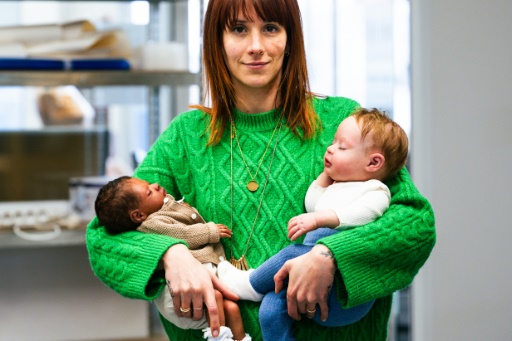Ultra-realistic movie prop babies are delivered by a Paris workshop.
A silicone babies skull, the newest creation from a studio that specializes in creating incredibly lifelike infants for the film and television industries, was stitched with hairs by Celine Lallement in a workshop outside of Paris.
Based in a suburb of north Paris, “Cinebebe” was founded in 2008 and creates props that can take over six weeks to complete before being delivered to production sets.
“The Angora goat is the source of this mohair. As she carefully inserted each strand, Lallement explained, “It mimics baby hair very well because it’s finer than adult hair.”
She noticed an issue at one point. She said, “There are two hairs in the same follicle, that won’t work,” and then she fixed the error with tweezers.
Her most recent creation will be featured in a film shoot in England, according to Justine Ray Le Solliec, who co-manages the special effects workshop.
With slightly red cheeks, tiny veins under the eyelids, skin folds and pores, it’s hard to tell the difference from a real child.
“You can expect to pay around 700 euros ($726) to rent a baby for a day’s shoot and between 9,000 euros and 15,000 euros to buy one, depending on the time required to make it,” said Ray Le Solliec.
From 26-week premature infants to 18-month-old toddlers, Cinebebe’s miniature mannequins are used in around 100 productions every year, mostly in France and Europe.
Their work has been glimpsed in hit Netflix series “Emily in Paris”, as well as the blockbuster 2024 French movie “The Count of Monte Cristo”.
The company uses silicone castings for babies, but also creates pregnant bellies, breasts, placentas, fetuses, umbilical cords, and even life-sized pelvis models that are used for birth scenes.
“In France, regulations prohibit newborns under three months old from participating in film shoots,” Ray Le Solliec explained. “For infants aged three months to three years, filming time is limited to one hour per day, which can be challenging when multiple scenes involve children.”
Beyond regulations, their business has accelerated since the COVID-19 lockdowns in 2020 and 2021.
“It helped us because babies were not allowed on set during that period,” she added.
Post-pandemic, their revenue has doubled every year, though there was a “slight slowdown” in 2024 compared to 2023, with a growth rate of 35 percent.
The next step is expanding internationally, with a London office planned in 2025.
Their production goal is to develop babies with open eyes as well as larger babies for stunt scenes.

